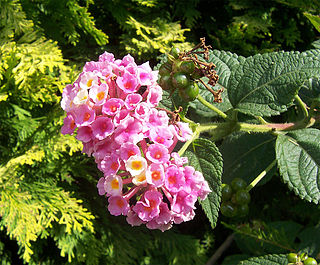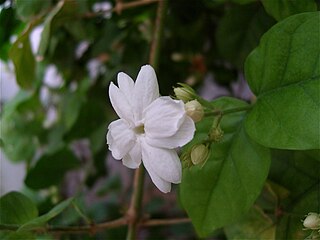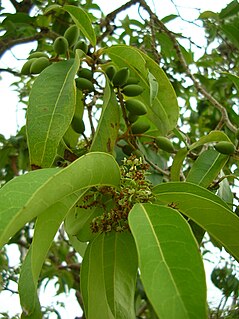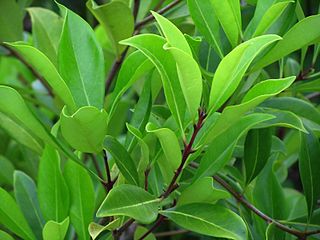
Syringa (lilac) is a genus of 12 currently recognized species of flowering woody plants in the olive family (Oleaceae), native to woodland and scrub from southeastern Europe to eastern Asia, and widely and commonly cultivated in temperate areas elsewhere.

Oleaceae, also known as the olive family, is a taxonomic family of flowering shrubs, trees, and a few lianas in the order Lamiales, It presently comprises 28 genera, one of which is recently extinct. The extant genera include Cartrema, which was resurrected in 2012. The number of species in the Oleaceae is variously estimated in a wide range around 700. The flowers are often numerous and highly odoriferous. The family has a subcosmopolitan distribution, ranging from the subarctic to the southernmost parts of Africa, Australia, and South America. Notable members include olive, ash, jasmine, and several popular ornamental plants including privet, forsythia, fringetrees, and lilac.

Jasmine is a genus of shrubs and vines in the olive family (Oleaceae). It contains around 200 species native to tropical and warm temperate regions of Eurasia and Oceania. Jasmines are widely cultivated for the characteristic fragrance of their flowers. A number of unrelated plants contain the word "jasmine" in their common names.

Forsythia, is a genus of flowering plants in the olive family Oleaceae. There are about 11 species, mostly native to eastern Asia, but one native to southeastern Europe. Forsythia – also one of the plant's common names – is named after William Forsyth.

The Verbenaceae — the verbena family or vervain family — are a family of mainly tropical flowering plants. It contains trees, shrubs, and herbs notable for heads, spikes, or clusters of small flowers, many of which have an aromatic smell.

Fraxinus albicans, commonly called the Texas ash, is a species of tree in the olive family (Oleaceae). It is native to North America, where it is found from eastern Texas and southern Oklahoma in the United States, to the state of Durango in Mexico. Its natural habitat is in dry, rocky slopes, often over limestone.

Osmanthus is a genus of about 30 species of flowering plants in the family Oleaceae. Most of the species are native to eastern Asia with a few species from the Caucasus, New Caledonia and Sumatra.

Cartrema americana, commonly called American olive, wild olive, or devilwood, is an evergreen shrub or small tree native to southeastern North America, in the United States from Virginia to Texas, and in Mexico from Nuevo León south to Oaxaca and Veracruz.

Nyctanthes is a genus of flowering plants in the family Oleaceae, native to southeastern Asia. It is currently accepted as containing two species; other species previously included in this genus have been transferred to other genera, most of them to Jasminum.

Jasminum sambac is a species of jasmine native to tropical Asia, from the Indian subcontinent to Southeast Asia. It is cultivated in many places, especially across much of South and Southeast Asia. It is naturalised in many scattered locales: Mauritius, Madagascar, the Maldives, Christmas Island, Chiapas, Central America, southern Florida, the Bahamas, Cuba, Hispaniola, Jamaica, Puerto Rico, and the Lesser Antilles.

Prodromus Systematis Naturalis Regni Vegetabilis (1824–1873), also known by its standard botanical abbreviation Prodr. (DC.), is a 17-volume treatise on botany initiated by Augustin Pyramus de Candolle. De Candolle intended it as a summary of all known seed plants, encompassing taxonomy, ecology, evolution and biogeography. He authored seven volumes between 1824 and 1839, but died in 1841. His son, Alphonse de Candolle, then took up the work, editing a further ten volumes, with contributions from a range of authors. Volume 17 was published in October 1873. The fourth and final part of the index came out in 1874. The Prodromus remained incomplete, dealing only with dicotyledons.
The Melchior system, "a reference in all taxonomic courses", is a classification system detailing the taxonomic system of the Angiospermae according to A. Engler's Syllabus der Pflanzenfamilien (1964), also known as "modified or updated" Engler system.
Native olive is a common name for several plants and may refer to:

Oleeae is a tribe of flowering plants in the olive family, Oleaceae.
Myxopyreae is a tribe of flowering plants in the olive family, Oleaceae.

Forsythieae is a tribe of flowering plants in the olive family, Oleaceae.
Hesperelaea is a plant genus with only one species, probably now extinct. Hesperelaea palmeri was found only on Guadalupe Island, a small island in the Pacific Ocean, part of the Mexican state of Baja California, about 400 km (250 mi) southwest of Ensenada. The last collection of the plant on the island was in 1875, so the species and the genus must now be presumed extinct. An intensive search for the plant in 2000 was unsuccessful.

Cartrema is a genus of a few species of flowering plants in the family Oleaceae, native to southeastern Asia, southern China, and North America, formerly treated as section Leiolea of Osmanthus. Species of Cartrema may be distinguished from those of Osmanthus by the paniculate inflorescences of the former.
Peter Shaw Green was an English botanist.
Alexander von Lingelsheim was a German botanist and pharmacist.













